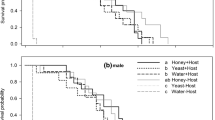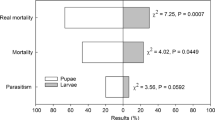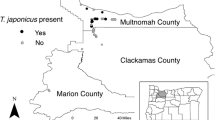Abstract
Frass from larvae of the corn earworm,Heliothis zea (Boddie) and scales fromH. zea moths (that are known to contain the host-seeking stimulus, tricosane) stimulate and orient host-seeking activity in femaleMicroplitis croceipes (Cresson), a larval parasite ofH. zea, andTrichogramma spp., egg parasites ofH. zea. When larval frass, moth scales, and tricosane were used as sign stimuli (releasers) forM. croceipes, T. pretiosum (Riley), andT. achaeae Nagaraji and Nagarkatti, respectively, at time of their release from laboratory containers, parasite performance improved, resulting in significantly increased rates of parasitization over that of unstimulated parasites. Stimulation ofM. croceipes with larval frass had an overriding effect on this parasite's innate tendency to disperse upon release, thereby increasing the numbers remaining and prolonging their retention in the target area. Supplying the appropriate host-seeking stimuli to these 3 hymenopterous parasites ofH. zea at time of their release to improve their efficiency greatly increases the probability of their effective utilization in pest management systems.
Similar content being viewed by others
References
Brown, W.L., Jr., Eisner, T., andWhittaker, R.H. 1970. Allomones and kairomones: Transpecific chemical messengers.Bioscience 20:21–22.
Hess, E.H. 1965. Ethology: An approach toward the complete analysis of behavior, pp. 15–33,in T.E. McGill (ed.). Readings in animal behavior.
Jones, R.L., andLewis, W.J. 1971. Physiology of the host-parasite relationship betweenHeliothis zea andMicroplitis croceipes.J. Insect Physiol. 17:921–927.
Jones, R.L., Lewis, W.J., Bowman, M.C., Beroza, M., andBierl, B.A. 1971. Host-seeking stimulant for parasite of corn earworm: Isolation, identification, and synthesis.Science 173:842–843.
Jones, R.L., Lewis, W.J., Beroza, M., Bierl, B.A., andSparks, A.N. 1973. Host-seeking stimulants (kairomones) for the egg parasite,Trichogramma evanescens. Environ. Entomol. 2:593–596.
Lewis, W.J., andBurton, R.L. 1970. RearingMicroplitis in the laboratory withHeliothis zea as hosts.J. Econ. Entomol. 63:656–658.
Lewis, W.J., andJones, R.L. 1971. Substance that stimulates host seeking byMicroplitis croceipes (Hymenoptera: Braconidae), a parasite ofHeliothis species.Ann. Entomol. Soc. Am. 64:471–473.
Lewis, W.J., Jones, R.L., Nordlund, D.A., andSparks, A.N. 1975a. Kairomones and their use for management of entornophagous insects. I. Evaluation for increasing rates of parasitization byTrichogramma spp. in the field.J. Chem. Ecol. 1:343–347.
Lewis, W.J., Jones, R.L., Nordlund, D.A., andGross, H.R., Jr. 1975b. Kairomones and their use for management of entornophagous insects. II. Mechanisms causing increase in rate of parasitization byTrichogramma spp.J. Chem. Ecol. 1:349–360.
Lewis, W.J., andRedlinger, L.M. 1969. Suitability of eggs of the almond moth,Cadra cautella, of various ages for parasitism byTrichogramma evanescens.Ann. Entomol. Soc. Am. 62:1482–1484.
Whittaker, R.H., andFeeny, P.O. 1971. Allelochemics: Chemical interaction between species.Science 171:757–770.
Author information
Authors and Affiliations
Additional information
Hymenoptera: Trichogrammatidae.
Hymenoptera: Braconidae.
In cooperation with the University of Georgia College of Agricultural Experiment Stations, Coastal Plain Station, Tifton, Georgia 31794.
Mention of a proprietary product does not constitute endorsement by the USDA.
Rights and permissions
About this article
Cite this article
Gross, H.R., Lewis, W.J., Jones, R.L. et al. Kairomones and their use for management of entomophagous insects: III. Stimulation ofTrichogramma achaeae,T. pretiosum, andMicroplitis croceipes with host-seeking stimuli at time of release to improve their efficiency. J Chem Ecol 1, 431–438 (1975). https://doi.org/10.1007/BF00988584
Received:
Revised:
Issue Date:
DOI: https://doi.org/10.1007/BF00988584




